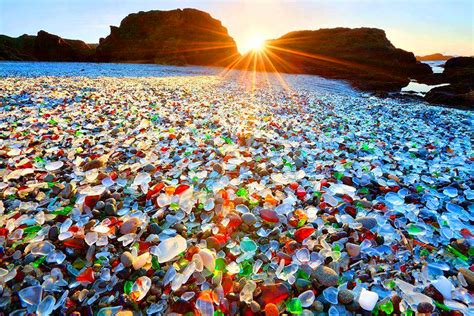Have you ever visited a beach that is full of colored glass pieces? It’s most likely that you’ve seen a sea glass beach. Sea glass beaches are known for their abundance of glass pieces that have been eroded and smoothed by the sea, and they are a wonderful sight to behold. But many people wonder – can you take glass from sea glass beaches?
The simple answer is yes, you can take glass from sea glass beaches. However, it is important to be aware of the potential environmental impact of doing so. Sea glass beaches are a unique natural resource, and collecting glass from them can quickly lead to the depletion of the beach. In some cases, taking glass from the beach can be illegal, and in all cases, it is important to take only a few pieces and leave the majority of the glass behind.
When taking glass from a sea glass beach, it is important to be selective. Avoid taking any pieces that are still sharp, and never take pieces of glass larger than a thumbnail in size. Additionally, it is important to be aware that glass pieces from sea glass beaches can often be hundreds of years old, and therefore may have historical or cultural significance. If you’re unsure of the age of a piece of glass, it’s best to leave it alone.
If you do decide to take glass from a sea glass beach, it is important to remember that it is a finite natural resource. Be mindful of the impact you have on the beach, and be sure to minimize it as much as possible. Taking only a few pieces of glass from the beach can help to ensure that the beach remains a unique and beautiful sight for many years to come.
How To Find And Collect Sea Glass On A Beach
If you’ve always had a passion for collecting sea glass, you might be wondering how to find and collect it from the beach. Sea glass is a rare and beautiful find, and it can often be difficult to spot because of its small size. But with the right equipment and the right know-how, you can easily find and collect sea glass from any beach.
The first step in finding and collecting sea glass is to prepare the right equipment. The basic items needed are protective gear, a bucket, a sieve, gloves, and a small tool. Protective gear such as a hat and sunglasses are essential, as they can protect your eyes from the sun and sand. Gloves are also recommended to keep your hands from getting scratched by the sharp edges of the sea glass. A bucket and a sieve are necessary to collect and store the finds, and a small tool can be used to pick up pieces of sea glass that may be partially buried in the sand.
Once you have the necessary items, you’re ready to start looking for sea glass. Begin by walking along the beach, looking for pieces of glass near the water’s edge. If you’re lucky, you’ll find some larger pieces of glass shining in the sun. Keep an eye out for smaller, harder-to-spot pieces, too. Once you’ve found a piece of sea glass, use your tool to carefully scoop it up and put it in your bucket.
When you’ve collected enough sea glass for your collection, it’s time to do some cleaning. Carefully rinse the pieces with fresh water to remove any salt or dirt. You can also use a soft brush to remove any stubborn dirt. After cleaning, let the glass air-dry. Then, you can start arranging your sea glass collection in a creative way, whether it’s on a display shelf or simply in a jar.
If you’re looking for an exciting way to spend a day at the beach, consider taking a trip to a sea glass beach. Many beaches are known for having large quantities of sea glass. If you can find one of these beaches, you’ll have a greater chance of finding bigger pieces and rare colors. Remember, however, that it’s illegal to take glass from sea glass beaches, so be sure to check the rules before collecting any glass.
The Benefits Of Collecting Sea Glass From The Beach
Sea glass beach has become one of the most popular attractions in recent years. As its name suggests, sea glass beach is a beach where sea glass is found in abundance. This unique form of glass has been washed ashore after being thrown away from the sea, and it is usually found in the form of small, smooth glass pebbles. Collecting sea glass can be a great way to add a touch of beauty and wonder to your home or garden. Here are some of the benefits of collecting sea glass from the beach.
The first benefit of sea glass collecting is that it provides a great way to interact with the environment. Collecting sea glass gives you the opportunity to explore your local beach, get to know the natural environment, and even engage in some scientific observation. By picking up the pieces of glass, you can learn about how the sea has been affected by pollution and how the glass is changing the environment. This can be a great way to encourage children to become involved in environmental studies.
The second benefit of collecting sea glass is that it is a great way to create beautiful, handmade decorations for your home or garden. Sea glass can be used to create beautiful mosaic art, jewelry, and even whimsical decorations for your home. With a little creativity, sea glass can be used to create unique pieces of art and decor for your space.
The third benefit of collecting sea glass is that it is relatively inexpensive. The cost of sea glass beach is relatively low, as it can usually be found in the form of small shards or pebbles at no cost. Although you may need to invest in a few tools to help collect the glass, overall the cost of collecting sea glass is relatively low compared to other forms of collecting.
The fourth benefit of collecting sea glass is that it can be a great way to relax and unwind. Collecting sea glass can be a great way to take a break from the hustle and bustle of life and to get away from the stresses of everyday life. Collecting sea glass can be a calming and soothing activity, and it can be a great way to take a break from the hectic world.
In conclusion, collecting sea glass can be a great way to add a touch of beauty and wonder to your home or garden. With a little bit of creativity, sea glass can be used to create one-of-a-kind pieces of art and decor. In addition, sea glass beach is an inexpensive and enjoyable way to interact with the environment and to take a break from the stresses of everyday life.
 Road Topic Tourism & Travel
Road Topic Tourism & Travel




